Louis Moinet Space Revolution 2021: Science Fiction Fantasy Space Battle On The Wrist
After selling out the first edition of the fantastical eight-piece Space Revolution in 2020, Louis Moinet introduces a second edition of eight pieces differing from the first in several cosmetic ways harmoniously fitting with the cosmic theme.
Louis Moinet founder and CEO Jean-Marie Schaller has always been fascinated with space, and the theme can be found again and again in the brand’s unique, rare, and imaginative timepieces. Just have a look at masterpieces like the Spacewalker and Space Mystery.
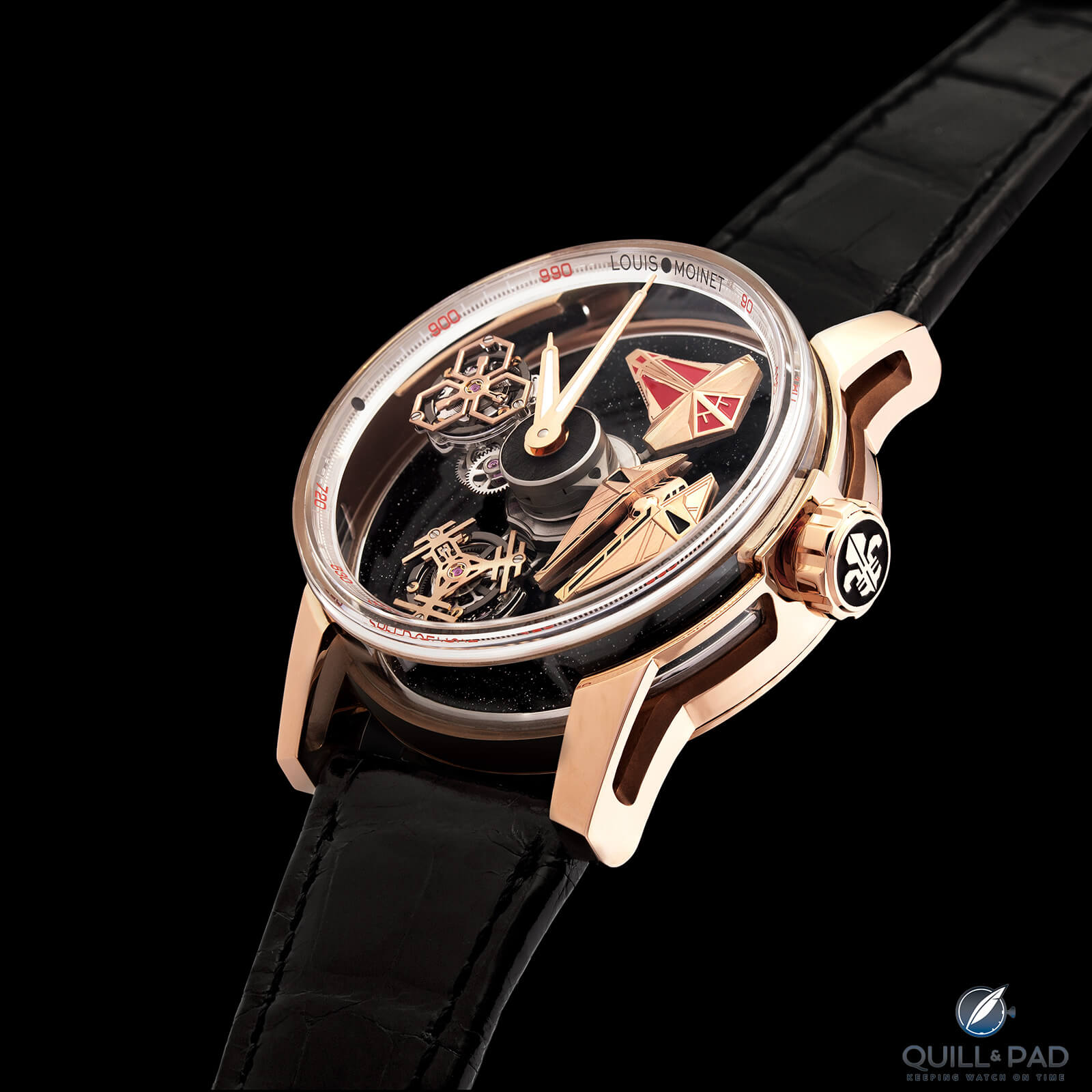
Louis Moinet Space Revolution 2021
This fascination has led to several extraterrestrial timepieces, most recently the Space Revolution, a complicated double tourbillon timepiece featuring something that can be found nowhere else: eight unique meteorite fragments, a different one for each watch. And these eight are different from those of the Space Revolution’s first edition.
Let’s take a look at the special technology and space connections of this timepiece, starting with the functionalities of the movement.
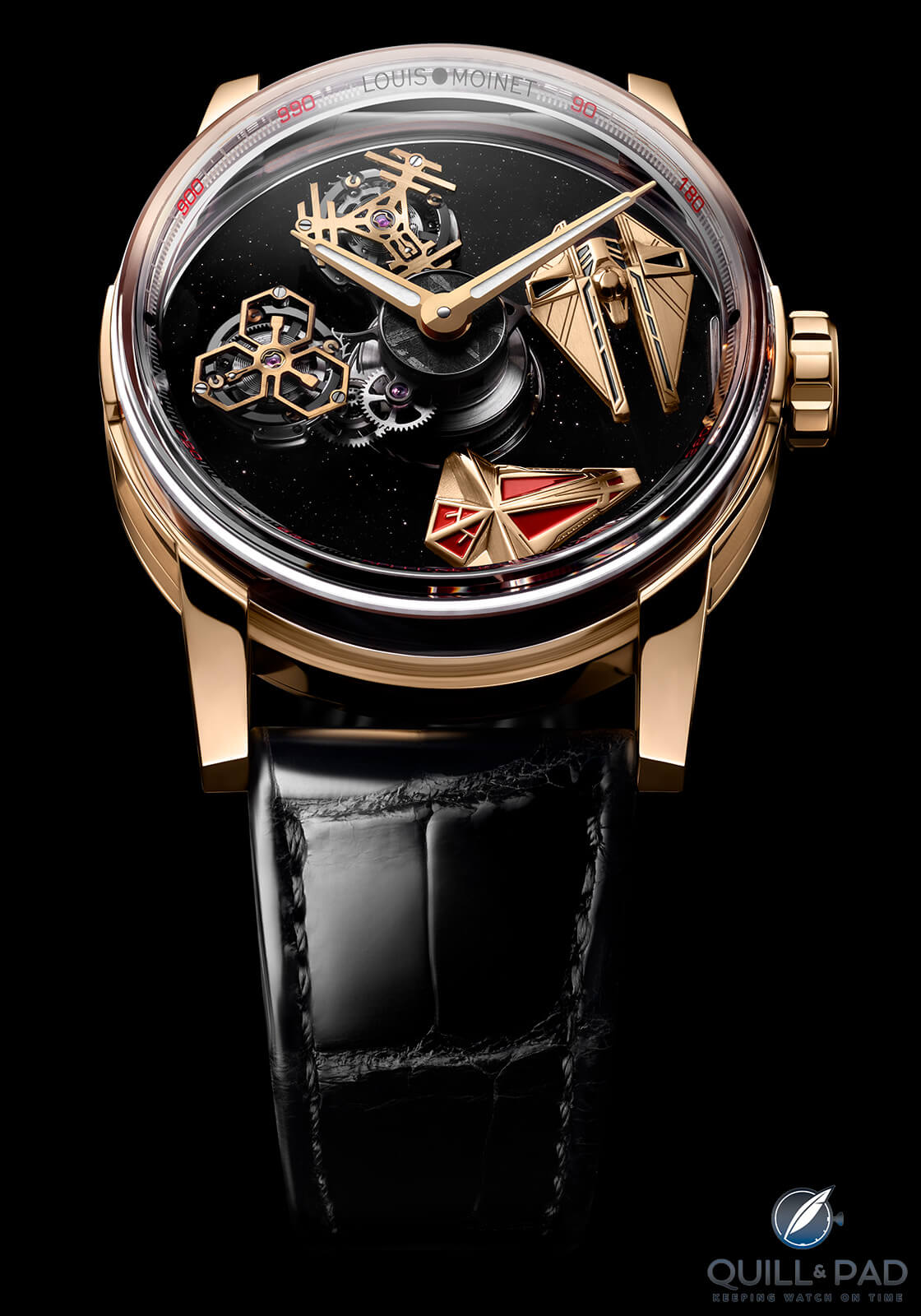
Louis Moinet Space Revolution 2021
Louis Moinet Space Revolution
The movement of Louis Moinet’s Space Revolution required more than three years of research and development, and I’m sure by the time you’re done reading this you’ll understand why.
This movement is unique in that it very visibly displays two tourbillons orbiting the dial in opposite directions. But that’s not all: each of these tourbillons carries a little titanium spaceship on its “tail.”
The spaceships and tourbillons are placed on different levels and cross each other 18 times an hour, looking for all the world like they are partaking in an epic space battle.
One makes a complete revolution clockwise in five minutes, while the other rotates counterclockwise, completing its orbit in ten minutes. This means that the dial rarely, if ever, looks the same when you glance at it. The effect is pure science fiction on the wrist, like turning the page of a favorite fantasy novel and finding the next awe-inspiring detail there. Each and every glance is a new visual.
The two hand-finished spaceships now presented in different color schemes than the previous version are made of high-tech, ultra-light titanium, a material perfect for flying through the spatial confines of a watch crystal without dragging the movement and stealing unnecessary energy from it. They are hand-lacquered with hybrid ceramic colors, weighing in at half a gram apiece.
They not only prove to be excellent entertainment with their night-sky clashes, they also act as counterweights to the twin orbiting 60-second tourbillons. Differential gearing averages the rates of the two tourbillons, augmenting the movement’s precision.
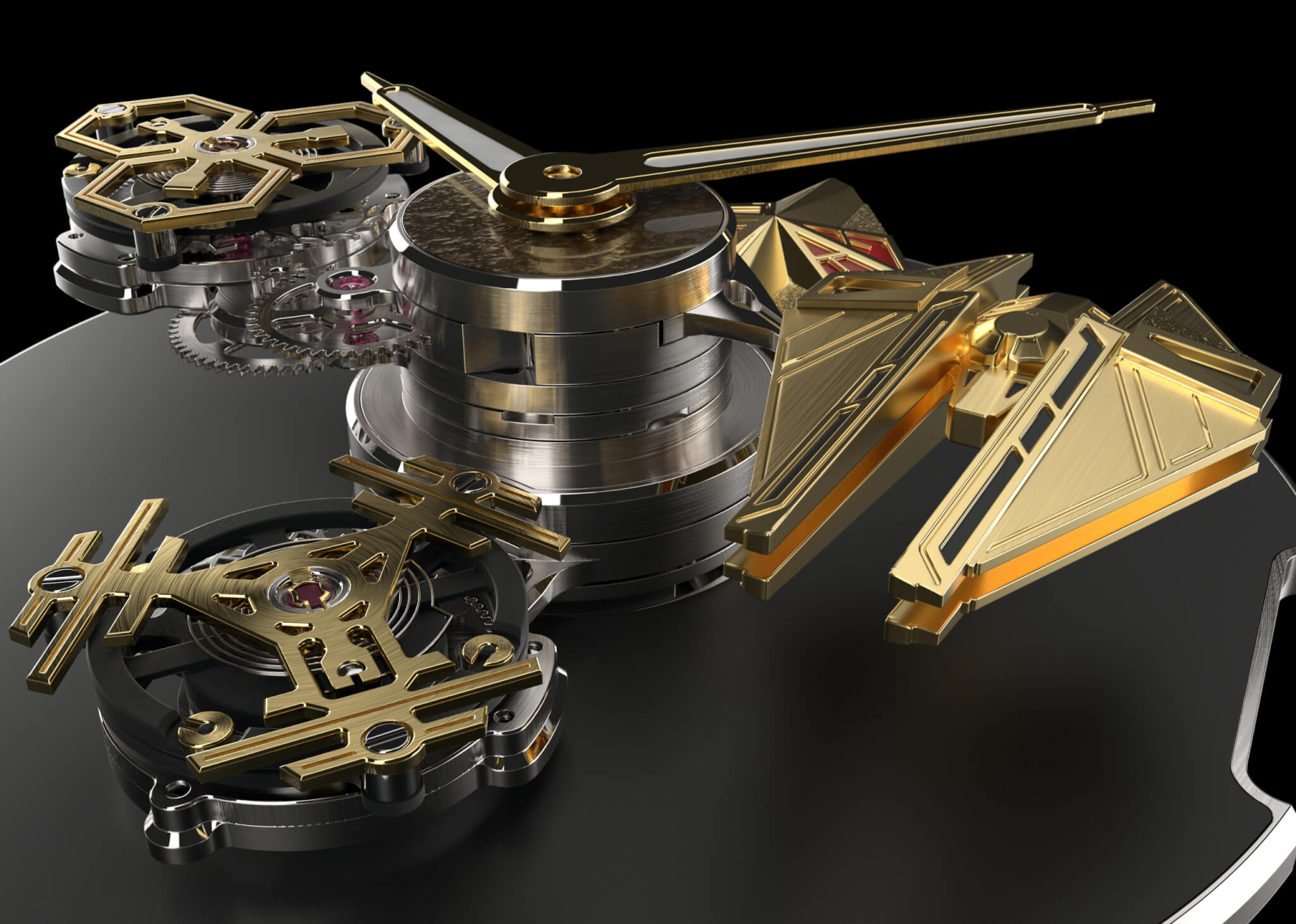
Tourbillons and starships on the dial of the Louis Moinet Space Revolution 2021
Tirelessly, the kite-shaped vessels face off 18 times per hour – or every three minutes and 20 seconds. The top spaceship, Black Force, flies a clockwise holding pattern around the dial, while the lower-level craft, Red Force, circles the dial in an eternal counterclockwise revolution below it.
Louis Moinet Space Revolution: technology
This movement originally imagined by Schaller is so complex that the watchmaker can only assemble one of these watches in the space of a month. Each movement comprising 470 components is dominated by the two visible rotating and revolving oscillating escapements connected by a differential gear to average out rates and errors, maximizing accuracy.
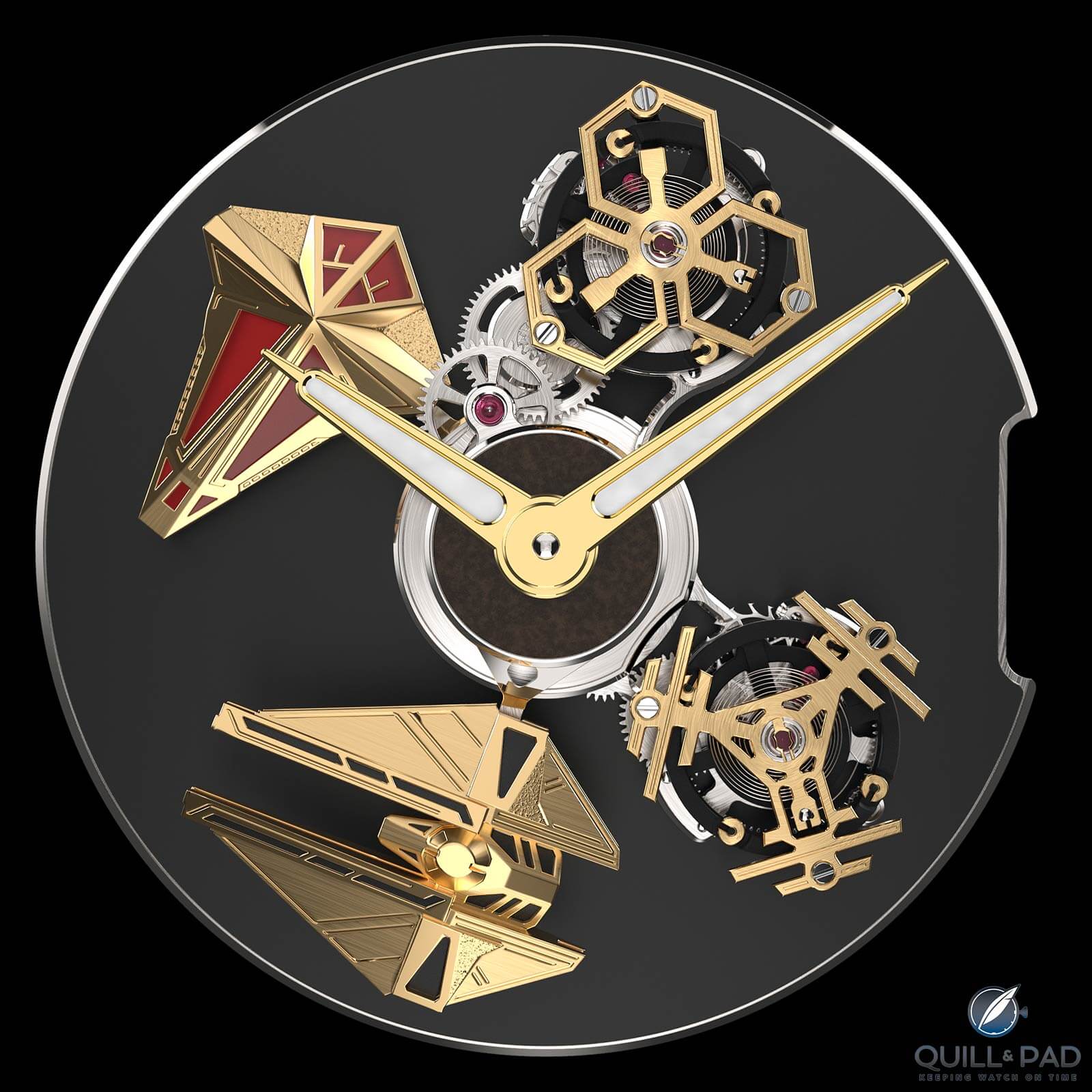
Top of the movement of the Louis Moinet Space Revolution 2021
It is only the tourbillons with their gearing and spaceships that remain visible above the plate of black aventurine, furthering the illusion of the mechanical ballet playing out in space. The titanium tourbillon cages are respectively hexagonal and geometrically shaped, each cage weighing only 0.24 grams thanks to the light metal.
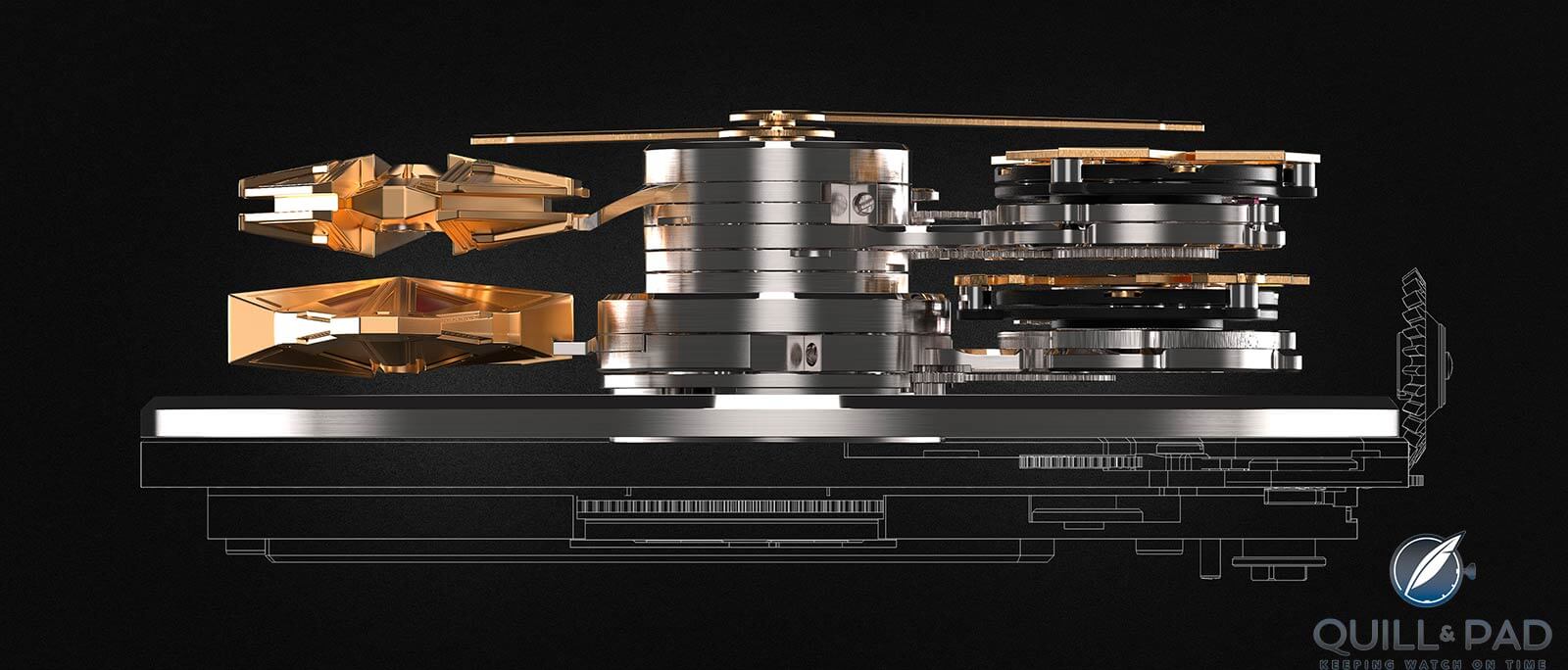
Side view of the movement of the Louis Moinet Space Revolution 2021
The “mysterious” base mechanism, which is only 3.75 mm in height, is “hidden” underneath the backdrop of the aventurine dial with the gear train stacked in a central column, transmitting “orders” to the tourbillons, spaceships, and time-telling hands. The point of this engineering feat is to keep the space spectacle pure and the star of the show.
All this sci-fi theater extrudes from the central, multifunctional pillar made of titanium and gold, the smooth running of which is only possible thanks to no less than six ceramic ball bearings. The movement contains an incredible total of 44 ceramic ball bearings!
Louis Moinet Space Revolution: the real space connection
As if that were not enough, there is also a literal space connection at the top of the central pillar: a unique meteorite fragment at the base of the gold Super-LumiNova-filled hands. On one of the eight limited edition watches this fragment comes from the moon; on another from Mars; on yet another from the oldest known rock in the solar system; and still another is a meteor fragment containing amino acid, which scientists surmise holds the secret to the beginning of life.
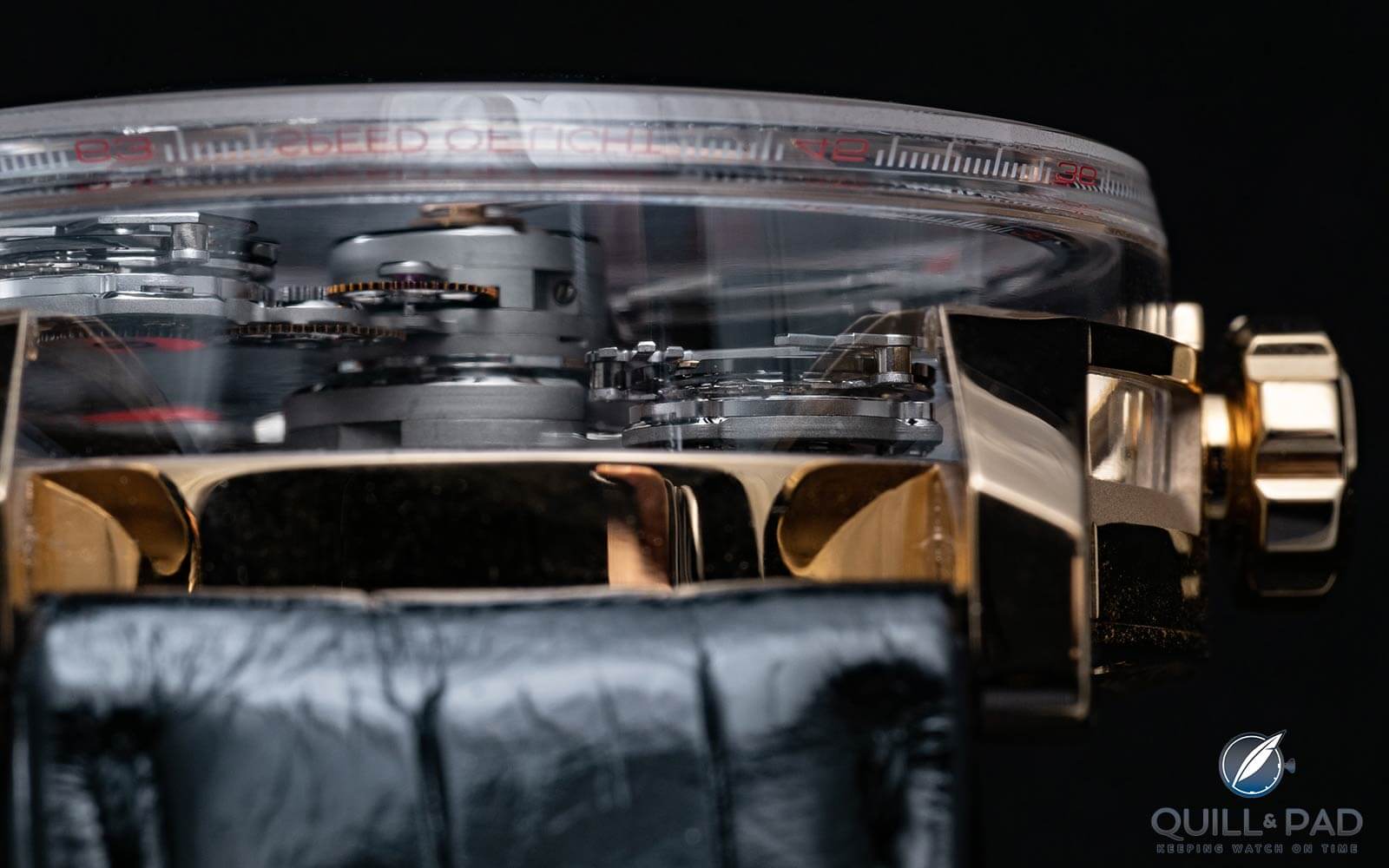
Extremely open action and mechanics of theLouis Moinet Space Revolution 2021
Meteorites are the occasional aftermath of those streaks of light we sometimes see across the night sky. They are the remnants of meteors that burned through our atmosphere and hit the ground. Louis Moinet explored the “where did we come from?” question in 2017 with a symbolic meteorite containing amino acid in a watch called Space Mystery. Now this question is back for one lucky owner of the Space Revolution version containing the Jbilet Winselwan meteorite fragment.
These unique space souvenirs make each of the eight watches in this edition unique. Other meteorite fragments on offer include Isheyevo meteorite, found in Russia in 2003, which is a carbonaceous chondrite meteorite containing a sequence of fine layers that gives it a very interesting and unusual look.
A third is Gibeon meteorite, an iron-nickel-based space rock exhibiting prominent Widmanstätten structures, the typical striations and patterns that become evident once the material is subjected to a chemical bath. Believed to have fallen to earth in prehistoric times, Gibeon was found in Namibia.
Yet another is Armanty meteorite, which is composed of extraterrestrial ferronickel alloy from the heart of an asteroid measuring more than 100 kilometers in diameter. It was discovered in recent years in China.
Representing eternity, the number eight figures into the Space Revolution symbolism as well. Aside from the eight meteorite fragments for eight watches, each watch contains eight animated elements: two hands, the two satellites forming the tourbillon cages, the dual tourbillons themselves, and the two battling spaceships.
All of this makes the Space Revolution one of the most action-packed horological shows I have ever seen.
And this horological show takes place against the dial backdrop of rare black aventurine, a deep black glass infused with copper flecks that looks much like winking stars in the night sky. In a nutshell, aventurine is a material that was discovered by chance – hence the name rooted in the Italian avventurina – by Italian glassblowers in Murano, Venice in the seventeenth century. Aventurine glass is made using transparent red copper ruby glass and a purpurin glass. When cobalt is substituted for copper, the glass turns blue, creating the type of aventurine primarily used in wristwatches. The glass contains flecks of copper that shimmer like stars in a midnight sky.
Louis Moinet loves to use aventurine in its watches, which I believe enhances their beauty while also adding to the idea of having a galaxy on the wrist. Schaller loves to work with aventurine glass on his otherworldly creations. “We work exclusively with Daniel Haas, who is a master in this field,” he once explained to me. The glass is difficult to work with, and often five dials need to be made in order to have one workable example. The high percentage of reject dials is due to the nature of the material: glass breaks easily, especially when cut at 0.5 mm. All this requires a lot of caution.

Louis Moinet Space Revolution 2021
The Murano black aventurine used in Space Revolution is very special as it was acquired more than 50 years ago by Haas’ father, the preeminent specialist in rare stones and aventurine in the luxury watch industry. Black aventurine is usually less shiny than blue aventurine because it has fewer flecks – so it’s perfect to emulate a stylized section of outer space.
The dial seems to float within the box crystal sapphire dome, creating the effect of looking into deep space.
A nod to the speed of light
If you look closely at what might be considered a translucent sort of flange you may wonder about the indexes and numerals there: what does 0-990 stand for? The numerals represent the speed of light, a playful design gesture reminding us of a fundamental cosmic aspect of physics.
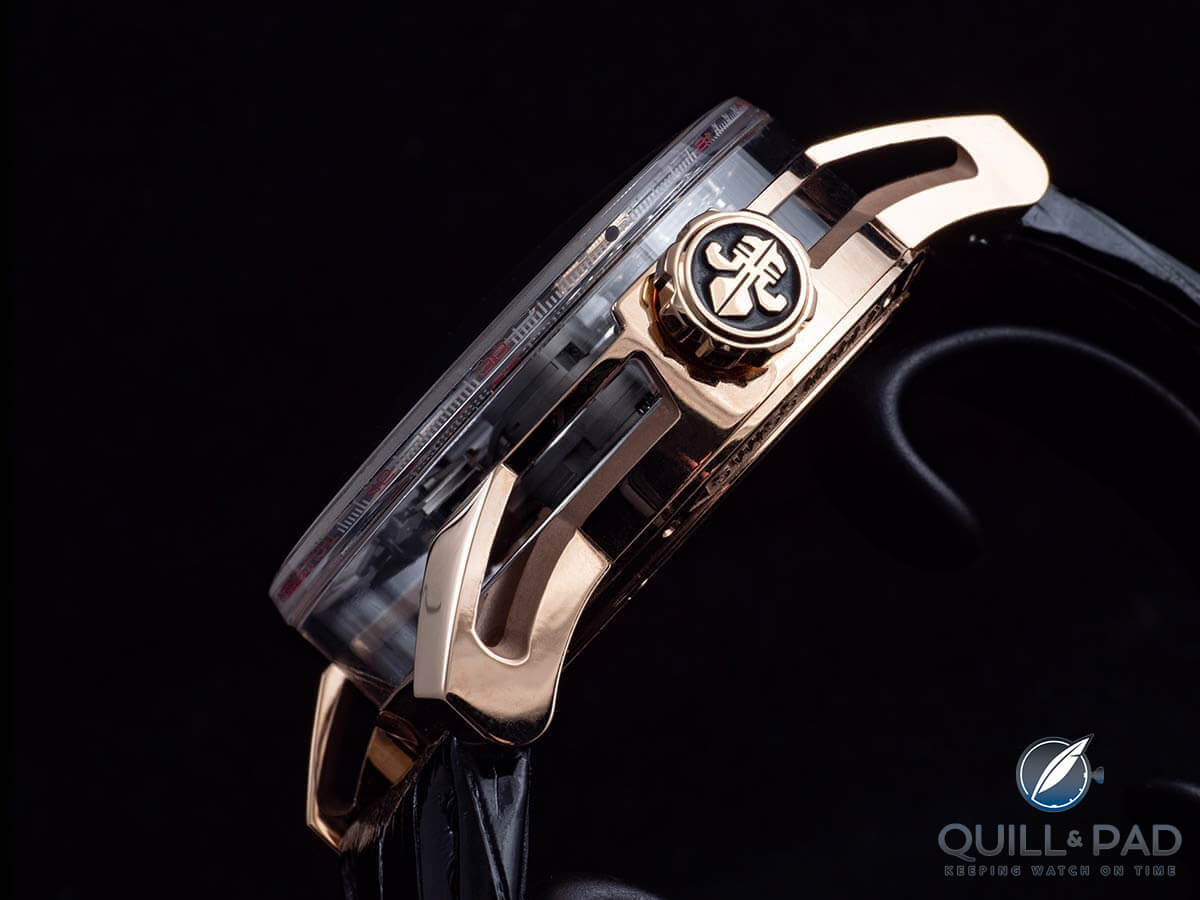
Louis Moinet Space Revolution in profile
The large 43.5 x 18.3 mm case is lighter and airier than its dimensions might have one think. Comprising 60.11 grams of 18-karat pink gold as a base, the lugs and case band are openworked for lightness and transparency.
The top and sides of this masterpiece are completely crafted in one piece of sapphire crystal weighing just 9.33 grams. The crystal is high on top to provide the spatial area needed to enjoy the space battle to its fullest. Thankfully, the crystal is also transparent on the sides so the observer may see the tourbillons and gearing at perpetual work. Maximum transparency was the maxim here.
Turning the gold case over reveals the twin mainspring barrels at 6 and 12 o’clock – not an unusual sight for a Louis Moinet movement – supplying energy to the whole system. What is unusual is the generously sized, user-friendly function selector for the crown (setting and winding).
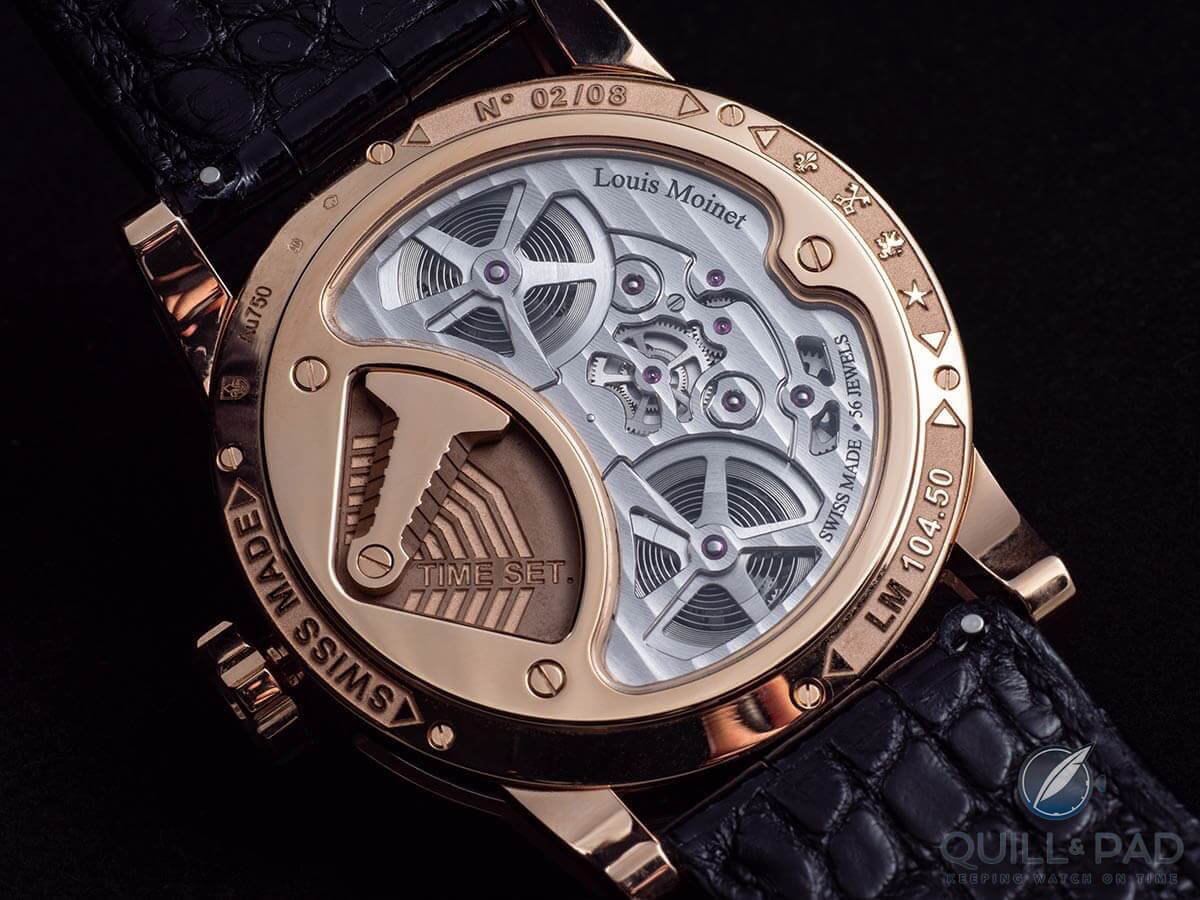
Back of the Louis Moinet Space Revolution
This means that the crown only has one position (and does not get pulled out) while the function selector has two: setting or winding the 470-component movement. A large crescent-shaped aperture reveals the spring barrels as well as the fine finishing including prominent Geneva stripes.
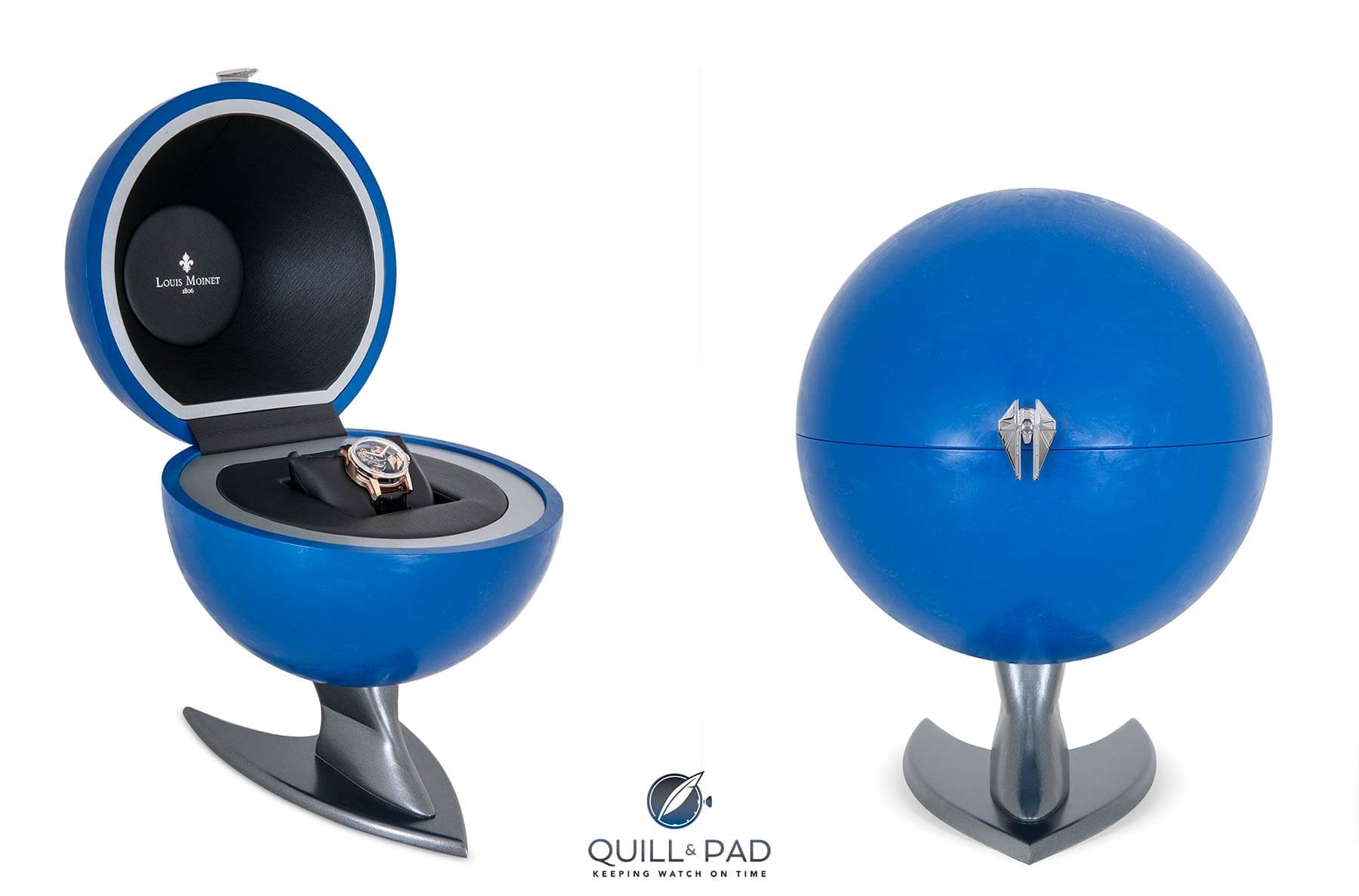
Louis Moinet Space Revolution 2021 presentation case (open and closed)
This ultra-fun watch outfitted with serious technology also comes in – what else? – a fun presentation box resembling a big blue ball (perhaps symbolizing the earth?) standing on a starship-shaped base. The box’s closure is a reproduced Black Force spaceship.
For more information, please visit www.louismoinet.com/watches/space-revolution.
Quick Facts Louis Moinet Space Revolution 2021
Case: 43.5 x 18.3 mm, pink gold
Dial: black aventurine
Movement: hand-wound Louis Moinet Caliber LM 104 with two separate one-minute tourbillons, 21,600 vph/3 Hz frequency, 48-hour power reserve, twin mainspring barrels
Functions: hours, minutes; spaceship animation, crown function selector on back (winding and time setting)
Limitation: 8 pieces, each with a unique meteorite in the center
Price: 360,000 Swiss francs
You may also enjoy:
Louis Moinet Spacewalker: Spectacularly Highlighting First Human Spacewalk By Alexey Leonov
Louis Moinet Space Mystery: Amino Acids Abound!
Aventurine: Sparkling, Glittering, Mysterious, And Placing A Galaxy Of Stars On Your Wrist



Leave a Reply
Want to join the discussion?Feel free to contribute!